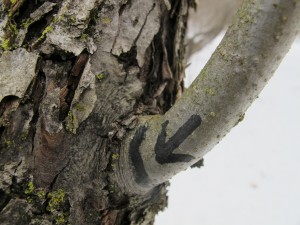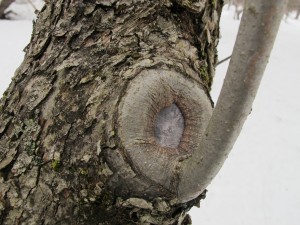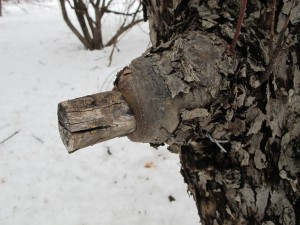Spring Pruning
Conventional wisdom has it that fruit trees should be pruned in March, but don’t worry if you haven’t even started yet. I haven’t. There’s no harm in pruning in April, or anytime, really. After the buds on fruit trees open, they are more prone to being knocked off while we work on the trees. But you probably don’t care if you get a few less apples or pears. The snow has been so deep this year that it has been difficult to move ladders around, keeping most of us from starting early.
Pruning is best done with clean, sharp equipment. You’ll need a pair of by-pass hand pruners and a sharp tri-cut pruning saw. Bow saws, once popular, are tough to get in tight places, so the folding saw has taken over. A nice pair of loppers will save time sawing medium-sized branches.
Before beginning, check your pruners to see if they are sharp. I do that with the backside of a fingernail, which I drag lightly across the cutting blade. It should shave off a little of the nail. (If yours are not sharp, read my description of how to sharpen pruners in my book, Organic Gardening (not just) in the Northeast: A Hands-On, Week-by Week Guide. Your library should have it).
Next I clean off any gunk on the blades. I use a special solution called Sap-X with an old green scrubby, but you could use a little sewing machine oil or even kerosene. The blades should open and close easily.
Start working on a tree by studying it for a few minutes. Apples do best with a single leader in the middle and the longest branches near the base, getting shorter going up the trunk. If you have two competing leaders, it would be good to remove one, though in an old tree that might not be practical due to the size.
As you look at the tree, ask yourself which larger branches should be removed. Are there any dead branches? They must be removed, so start by taking them out. Are there branches that are rubbing others, or crossing through the middle of the tree? They can go next. Lastly, remove any watersprouts – those smaller branches shooting straight up.
Some fruit trees produce dozens – or even hundreds – of water sprouts each year. Although some varieties seem more prone to producing them than others, you can minimize their presence by pruning to create a well-balanced tree that allows sunshine to get to each leaf of the tree. Watersprouts are the tree’s effort to produce more leaves to create more food.
Even though it might seem scary, it is better to remove large branches than to nip away at a tree, taking tiny branches. It is more efficient, and makes for a better looking, healthier tree. In any given year you can remove up to a quarter of the tree. That means a quarter of the branches that produce leaves – and hence food for the tree. Taking out a big dead branch doesn’t count at all. A healthy tree allows each leaf to get sunshine. If there are too many branches, they will shade each other out.
Where you make your cuts is important, too. Don’t cut off branches flush with the trunk, nor leave long stubs. Branches should be pruned just outside (away from) the wrinkly flare that starts at the trunk or a larger branch. That area you should leave is called the trunk collar. It is the site where healing takes places fastest. Years ago arborists recommended painting tar over a cut, but that is no longer thought to be a good practice.
If you have an empty place in your tree and wish you had a branch there, sometimes you can bend down a branch and keep it in place until it will stay put – generally around July 4th. But don’t do that until after the leaves appear. You can attach a weight to a small branch. A plastic soda bottle is good: you can add water until it is just the right weight. Or you can tie a bigger branch down to a stake in the ground.
Apples generally are produced on short spurs that occur on scaffold branches that are at a 45 degree angle from the main trunk (or even more horizontal). Branches going straight up are less likely to produce fruit. But don’t be impatient with young trees: they won’t produce fruit until they are good and ready.
Pruning on a warm spring day is great fun, and a good excuse to be outside. And remember, trees are not like people: they benefit by having their limbs removed.
Henry Homeyer lives in Cornish Flat, NH. His Web site is www.Gardening-Guy.com.





